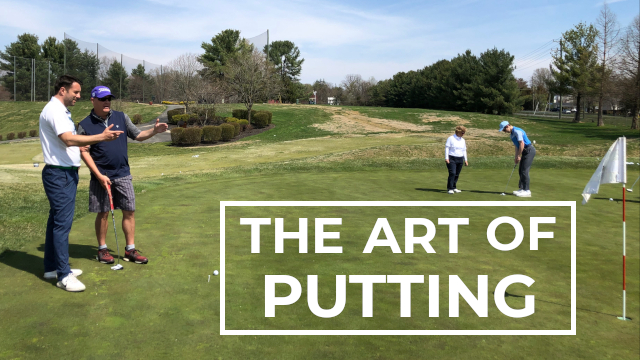
SWITCHING ON THE “ATHLETIC MIND”
The ball being stationary in golf can be both a positive and a negative. It’s a positive in the sense that you get time to consider the situation in front of you and figure out the best shot, but it can be a negative in the sense that it can open up a window of time for you to think before and during your stroke. Athletic motion is optimal when the mind is quiet – you’re not thinking – you’re using your senses to connect directly with your environment and using your “mind’s eye” to see (and feel) what you intend to happen. You are deeply focused and at one with your target and your intention.
Making the right length and speed of stroke and squaring the face to your intended start line (once you’ve set up and aligned correctly) requires you to have your “athletic mind” switched on and your “thinking brain” switched off. This is something that takes practice.
The athletic mind doesn’t do technical instruction or thinking about what the consequence will be if you make or miss a putt – instead it’s intuitive and only in the present moment. In his book “The Inner Game of Golf”, Tim Gallwey differentiates between the thinking, ego-driven mind and the intuitive, subconscious mind calling them “Self 1” and “Self 2” respectively. In the optimal state of mind for putting, a player’s sense of Self 1 is transcended and he/she is at one with the putt, in the moment, living only through Self 2.
The best putters are both artists and athletes. They can engage the right side of the brain (the visual and creative side) and turn off thinking, allowing the stroke to happen without conscious thought. Unlike poor putters, they don’t over-think the putt, have doubt or guide the stroke. If the athletic mind is fully engaged, the movement centers of your brain will have direct access to all the necessary information about that putt to make the required stroke, without you thinking about it or being aware of it.
HOW TO PRACTICE THE ART OF PUTTING: GREEN READING
In order to reduce the influence of the analytical Self 1 before and during your stroke, you have to use it to determine the line and speed of the putt. Believing that you have the right line and speed into the hole, will allow the thinking mind to quiet over the ball, as all its questions will have been answered.
Walk around the putt and see it from all sides. I also like to use Aim Point Express, straddling the line at different points in the putt, and (with my eyes closed) feeling which of my feet has more weight on it to determine where gravity will take the ball.
VISUALIZATION
Being able to “see” the line of the putt before you start your stroke is important sensory information which your subconscious mind will use to perform the stroke. Try to imagine how fast or slow the ball will be rolling down the line and where on the hole it will enter. Craig Farnsworth, “The Putt Doctor”, suggests moving your eyes up and down the line at the same speed that the ball will take. Will it die into the hole or enter the cup with pace? There is more than one line into the hole. Visualization for golf takes practice and is something that you can improve over time.
FEEL
Can you imagine what a putt will feel like without moving your putter? Can you close your eyes right now and imagine the stroke and strike on a 10ft putt? Try to do this. You can use your rehearsal strokes in your Pre Putt Routine to “feel” the stroke and impact. Hold onto those sensations when you are over the ball. Again, this is information about the putt that your subconscious will use to make the right length of backstroke. In the Golf State of Mind Putting System, I have plenty of practice drills to improve the use of imagination, one being closing your eyes while putting, so you are forced to anticipate and improve your sense of feel for different lengths of putt.
Positive DISTRACTION
If your ego-driven, critical self is too active in the key moments, you can distract it, so you allow the athletic, subconscious mind to make the stroke. Before you start your putt, take a deep breath. Focus on the breath as the air enters your nose and as it leaves your lungs, via your mouth start your stroke. This will bring your focus to a calming breath rather than mental chatter. Counting can also provide a positive distraction.
PERFORMANCE TRAINING FOR PUTTING
A part of your practice should be dedicated to pressurized “performance drills”, where you simulate the golf course and practice your pre-putt routine. Your putting practice shouldn’t be about dropping balls and casually stroking them to different holes – it needs to be challenging, testing and pressurized.
The purpose of my Golf State of Mind Putting System is to improve your sensory connection with putts and train focus on process under pressure. In practice, we want to work on lowering the possibility for noise and distraction from the ego-driven self and train focus on the task at hand, allowing the athletic, subconscious mind to perform.
Thanks for reading!

